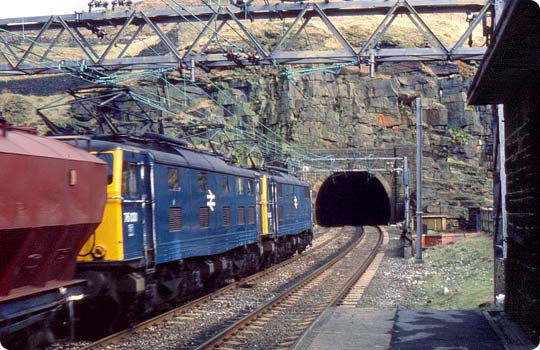Northern Way concerned for Woodhead's future

- Author: Graeme Bickerdike
- Source: RailStaff newspaper
- Published: February 08
Northern Way concerned for Woodhead’s future
Uncertainty still hangs over the long-term future of three disused railway tunnels as work to install power cables through one of them gets underway.
The National Grid intends to move its existing trans-Pennine electricity supply from a Victorian single bore at Woodhead into a newer tunnel, opened as recently as 1954. However the scheme has attracted considerable opposition from politicians, transport groups and environmentalists. The tunnel is the only one which could accommodate European gauge freight trains. Demand for 9’6” container movements between east and west coast ports is expected to increase significantly over the next 20 years. Campaigners believe that this traffic will be driven onto unsuitable and already congested roads unless the line through the tunnel is reopened.
It is a view supported by The Northern Way, a collaborative of the North’s three regional development agencies. Transport Director John Jarvis told RailStaff that its study into gauge enhancement has identified that, by 2030, there could be demand for 60 trains per day across the Pennines. “Currently traffic is suppressed by capacity and gauge. Teesport is awaiting a decision on a deep sea facility and work is ongoing around the Port of Liverpool. With those two and Hull, you begin to develop a sizeable market.”

Photo: Kevin Cooke (used under Creative Commons licence)
On 30th January, Secretary of State Ruth Kelly told the Transport Select Committee that her department had been in discussion with NG over the Woodhead issue. “They have informed me that were the business case to materialise…the fact that the National Grid has laid cables in those [Victorian] tunnels would not preclude their use in the future. Were the new tunnel to be needed, then I think those cables would have to be relaid.”
A spokesperson for the National Grid resisted calls for the cabling work to be put on hold. “We can’t plan our network on speculation. We’re happy to talk to people and we have discussed this with relevant parties over the past few months. But we have to maintain security of electricity supply – we don’t want lights out across the whole of Manchester. The deadline for replacing these cables is 2010. Our position doesn’t change unless there are definite plans to reopen the railway, backed by the government.”
NG says that the poor condition of the two Victorian tunnels is one of the reasons for its project. The south bore suffered a collapse in 1988 and, during the Nineties, there were two fires. A campaign group claims that the company has put a price-tag of £165million on their refurbishment. NG refutes this. The structures were recently the focus of a £4million reinforcement scheme. RailStaff understands that now only a 7 metre section of the south tunnel is a cause for concern. This has been stable for the past six months. The north tunnel remains in reasonable condition throughout.
The spokesperson agreed that the tunnels would be available for rail use when its equipment has been removed from them in 2011. However they will then be sealed and “At the moment we have no intention of maintaining them because we would have no reason to.”
The possibility of the tunnels effectively being abandoned is causing concern within The Northern Way. “There are obviously risks in an approach where nature takes its course and we want to understand what those risks are” states John Jarvis. “We’re arguing a precautionary approach. If they do relocate the cable into the 1954 tunnel, we’ve got to keep open the option of it being put back into the Victorian tunnels at some future date. There’s a very strong need for a new [trans-Pennine] line and we think that will be before 2030. Woodhead is a candidate route, that’s why we’re making the case for safeguarding it rather than letting it go.”





